Oregon once required counties to take care of their neediest residents. For decades, relief institutions known as “poor farms” operated throughout the state. They provided food, shelter, medical care and sometimes burial services. The treatment of residents varied widely, with some poor farms providing refuge for those in need while others operated more like prisons.
A century ago, on Nov. 6, 1923, the Multnomah County Poor Farm in Troutdale admitted 64-year-old Andy Dunn as a new resident in need of public support. The publicly funded relief institution operated as a working farm housing indigent residents.
Dunn arrived in Oregon in 1898 from Missouri and had worked as a general laborer for years, usually for the railroad. Census reports listed him as a widower living in boarding houses. Poor farm records say he suffered from a skin disease, but there is no other information about his condition. Dunn died at the poor farm in 1925, and his body ended up in a local mortuary. There is no record of a gravesite.
Dunn is just one of the thousands of people who quietly lived and died in one of Oregon’s many county poor farms — a bygone refuge for residents with no other options.
An early idea for local responsibility
In 1854, Oregon’s Territorial government required counties to care for their impoverished citizens, but no guidelines existed for how to do that. Sometimes, counties gave direct cash payments to those deemed “worthy,” such as widows or veterans. More often, counties operated some type of poor farm.
Author and historian Megan Birk spent years studying poor farms for her book “A Fundamental Institution.” She says, “A poor farm was designed to provide shelter and food and sometimes health care for people in communities who were destitute and people who couldn’t take care of themselves using any other type of aid.”
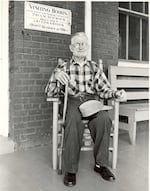
In this photo circa 1940s, a resident of the Multnomah County Poor Farm in Troutdale sits on the porch.
Courtesy of the Troutdale Historical Society
Poor farms operated in communities all over the country. Birk says, “Not quite every county had one, but they were the kind of dominant local form of aid and relief for people for decades. In fact, more than 100 years in most places.”
In a time before federal social security or other social programs, those living in poverty, the sick and injured, and the elderly had few options. Birk explained, “We’re very accustomed today to thinking about relief being federal, state and then maybe local, but the inverse is true for most of U.S. history. It is local, maybe state, but definitely nothing federal until we get to about the 1930s.”
Working farms as a refuge
Poor farms usually operated as working farms, providing a cost-effective way to care for several individuals. The Southern Oregon Historical Society holds some of the poor farm ledgers from early Jackson County.
Archivist Jan Wright says the records show a variety of people received help: “It was mostly old people and white men, but there are Chinese, there are Blacks. There are young people. There is a widow with four kids who are there temporarily. They just have nowhere else to go.”

This image from 1899 shows Frankie Baker as a young woman. She would later become a resident of Multnomah County Poor Farm.
Courtesy of UMSL Mercantile Library from St. Louis Post-Dispatch
Many people mistakenly believed that residents had to work for their care. Birk said residents sometimes helped around the farm but requiring manual labor was unrealistic. “What they found out very quickly was that people are coming to a poor farm as a means of last resort. They’re coming because they cannot work and sustain themselves, and if they could work enough to make enough money they wouldn’t be there.”
Each poor farm varied depending on needs and resources. Sometimes, counties owned and operated institution-like facilities, taking in hundreds of people. Smaller, rural counties often paid private contractors to take people into their homes in a type of foster care system.
Community care in private homes
In the 1870s, Lane County residents petitioned for community relief for its neediest residents. Public historian Marin Aurand said that, at first, the county adopted the foster care system. “Instead of buying land to have a poor farm, they decided to contract with other area residents who would open their houses up to these poor individuals and care for them in exchange for funds from the county.”
One of those houses belonged to Dr. Benjamin Russell of Thurston. In the 1880s, the aging doctor could no longer travel the county by horse, making house calls.
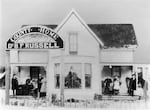
In this image, circa 1880s, Dr. Benjamin Russell and his family pose on the porch of their Lane County, Ore. home, which served as a county poor farm.
Courtesy of the Lane County History Museum
Aurand said that to pay his bills, the doctor and his wife Maggie began contracting with the county. “He operated what was essentially a free clinic out of his home.”
By all accounts, residents received good care from the Russells. Aurand said, “He had a wonderful reputation in the community.”
However, many other facilities provided the bare minimum. An 1892 state report found Jackson County’s poor farm small, old and utterly unsuited for its purpose: “The beds were narrow wooden bunks with straw mattresses. The bedding was not clean, and the beds looked far from comfortable.”
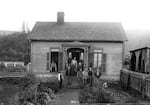
In this undated image, residents stand outside of the Jackson County, Ore., poor farm.
Courtesy of the Southern Oregon Historical Society
The first county-owned and operated poor farm
In 1868, Multnomah County opened the first county-owned and operated poor farm in what is now Southwest Portland’s Washington Park. The farm had two dormitory buildings, one for men and one for women. A nursery cared for orphaned or abandoned children. The grounds also contained a chapel, laundry, workshop, two barns, outbuildings and the superintendent’s residence. Employees included a matron, cook, doctor, farmhand and general laborer.
Within a few years, the Multnomah County poor farm had a notorious reputation. A series of investigations charged the superintendent with neglecting inmates, not providing enough food and overcharging for expenses. Newspaper reports from 1877 detailed deplorable conditions with headlines like “Filthy conditions at the poor farm shock Portland.”
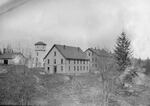
Laundry hangs on a line to dry outside one of Multnomah County's Hillside Poor Farm buildings, circa 1898.
Courtesy Multnomah County Archives
By the 1880s, a county report stated the farm had cared for 1,561 people. Of those, 435 were Black and just 73 were women. Local newspaper articles included stories about Chinese residents, such as a group of men with leprosy who eventually returned to China, but they did not appear in the report. Many names are missing, with few documents from the earliest years.
Birk says that in many places, there is no trace that a poor farm even existed. “A lot of physical poor farms are gone — counties needed the land for other things. The buildings were hard to maintain, expensive to upkeep and they didn’t necessarily evolve very successfully as structures.”
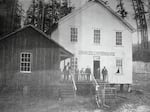
In this image from 1892, residents stand outside the Coos County, Ore., Infirmary, which operated as a local poor farm.
First Biennial Report of the State Board of Charities and Corrections, 1892
That includes Hillside, which operated for over 40 years in Portland’s sprawling Washington Park before finally closing in 1911. The buildings have long disappeared, and few records remain. Up until a recent donation to the Multnomah County Archives, only a few images were known to exist.
Over the years, construction work at the Oregon Zoo uncovered bodies believed to be from the old poor farm cemetery.
A model institution
With the closing of Hillside, Multnomah County opened a new and grander facility in Troutdale. In November 1911, over 200 residents moved from the old poor farm to the building.
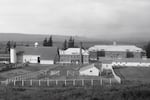
This image, circa 1911, shows the grounds and buildings of the Multnomah County Poor Farm in Troutdale, Ore.
Courtesy of the Troutdale Historical Society
The state-of-the-art building sat on 345 acres and operated a dairy and working farm that soon turned a profit.
Terry Baxter of the Multnomah County archives said it proved successful for decades: “They fed all the people at Edgefield, they fed everybody at the county hospital, they fed everybody at the jails and they sold surplus for profit. It was an operation that really worked for folks.”
The poor farm’s population peaked in 1935 with over 600 residents.
The Great Depression and the end of poor farms
That same year, there were 130,000 poor farms around the country. Oregon operated at least 17 of those, caring for thousands of residents.
However, with the Great Depression, governments became overwhelmed with an influx of transient and needy residents. Roosevelt’s New Deal, specifically the Social Security Act of 1935, brought a new federal funding structure and most poor farms began to disappear.
A few transformed into county hospitals and nursing homes, including Multnomah County’s Poor Farm, renamed Edgefield Manor. It operated in some form until 1982. After its closure, the county planned to tear down the old buildings, but the Troutdale Historical Society spent years fighting that decision. Eventually, the efforts paid off. In 1990, McMenamins bought the property and transformed it into the popular hotel and restaurant, Edgefield.

This undated photo shows the main building at McMenamins Edgefield in Troutdale, Ore.
Courtesy of McMenamins

Related: Priceless donations show the workings of Multnomah County's forgotten poor farm
Related: Lost then found: A time capsule revealed in Southern Oregon poor farm fire debris
